Midhurst (Easebourne prior to 1835), Sussex
Up to 1834
A parliamentary report of 1777 recorded parish workhouses in operation at Chithurst (for up to 6 inmates), Easebourne (26), Farnhurst (16), Midhurst and Liberty of St John (30), Rogate (18), Terwick (5), and Trotten (24).
In July 1792, the parish of Easebourne and fifteen neighbouring rural parishes formed a Gilbert Union. The other member parishes were Bepton, Cocking, Chithurst, Fernhurst, Iping, Linchmere, Lodsworth, Lurgashall, Selham, Stedham, Tillington, Treyford (or Trayford), Trotton, Woolbeding (or Woolbedding) and Woollavington. The Union erected a workhouse at Easebourne which opened on 10th October 1794. Its construction and furnishing cost a total of £6,161.17s.10d. The workhouse could house 180 inmates, and by October 1795, the number in residence was 159. As decreed by Gilbert's Act, these were primarily under 14 or over 60, although exceptions could be made to admit the physically or mentally infirm, or women with infant children.

Easebourne Gilbert Union workhouse, c.1792.
The layout of the ground floor of the workhouse is shown below.
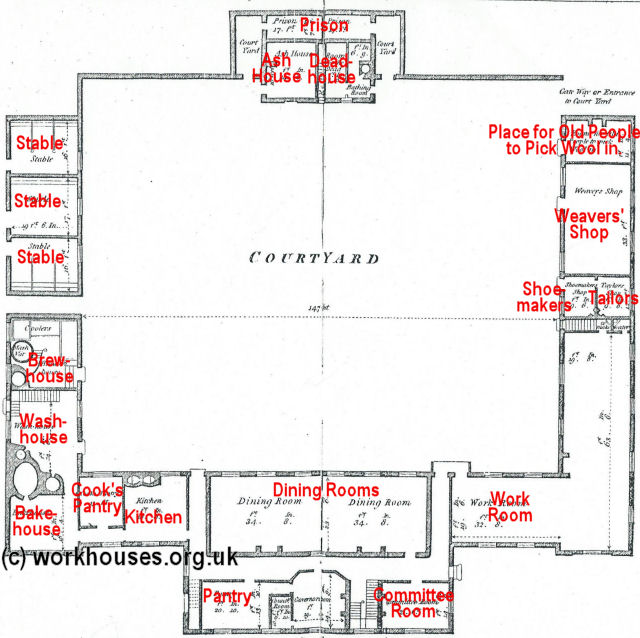
Easebourne Gilbert Union workhouse, c.1792.
The women performed domestic work, while men were employed in gardening, or were hired out for farm work. Children were trained in the manufacture of linen and wool.
The workhouse diet at this time was as follows: breakfast—bread and cheese, or water-gruel and milk-pottage, sometimes broth and onion-pottage; dinner—pudding, mutton and pork, trimmings, ox-heads and bacon, and coarse beef; supper—bread and cheese.
A report published in 1834 is reproduced below:
The workhouse at Easebourne, incorporated for 16 parishes about 40 years Since, is. farmed at 3s. 3d. a head. There is a garden containing two acres, and a field of the same size, belonging to the house; these, together with a farm of 50 acres, at the distance of three miles (which the governor rents on his own account), are cultivated by the labour of the inmates, of whom the average number in, summer is 60, and in winter 100: the house is capable Of containing 300. During the winter months there are in it from 25 to 30 able-bodied inmates, elnefly single men, who go away in spring, when the coppice-cutting commences, and continue absent during the haying, harvest and sowing time. In this house there were very few children, no school, and no manufacture or employment within doors. All the inmates are allowed to associate during the day, but were represented to be strictly separated at night, except the married, who have small rooms allotted to them. In this, as in the workhouse of East Preston, the diet is regulated by a printed scale, sanctioned by the visitor. The bread, cheese and meat (generally pork fed in the house, or beef procured from the butcher) appeared of an excellent description.
After 1834
Midhurst Poor Law Union was formed on 12th May 1835. Its operation was overseen by an elected Board of Guardians, 28 in number, representing its 26 constituent parishes as listed below (figures in brackets indicate numbers of Guardians if more than one):
County of Sussex:
Bepton, North Chapel (until 1869), Chithurst, Cocking, Didling, Easebourne, Elsted, Farnhurst, Harting (2), Iping, Linch, Linchmere, Lodsworth, Lurgashall, Midhurst (2), Rogate, Selham, Stedham, Terwick, Tillington, Treyford, Trotton, Woolbeding, Woollavington.
County of Southampton:
North Amersham, South Amersham.
Later Additions (from 1869): Graffham and Heyshott (formerly in Sutton Gilbert Union); East Lavington and West Lavington (following givision of Woollavington).
The population falling within the union at the 1831 census had been 12,239 — ranging from Didling (population 82) to Midhurst itself (1,478). The average annual poor-rate expenditure for the period 1831-34 had been £17,536 or £1.8s.8d per head of the population.
The new Midhurst Union continued to use the existing workhouse at Easebourne for the enlargement of which the Poor Law Commissioners an expenditure of £6,531 in 1836. The site location and layout of the Midhurst building can be seen on the 1910 map below.
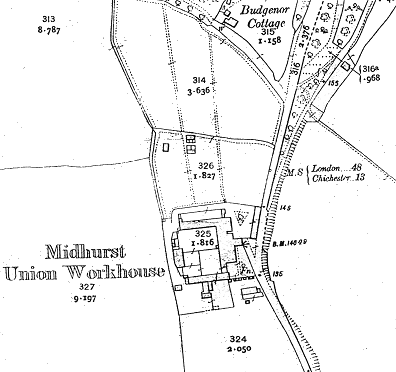
Midhurst workhouse site, 1910.
The workhouse buildings surrounded a large courtyard which measured 147 feet across north to south. The main block at the east had a central doorway facing towards the road. The ground floor originally contained the Governor's room at the front centre with a committee room to north. The inmates' dining rooms were at the rear with the kitchen to their south. A single storey board-room was later added at the north-east front of the main block.
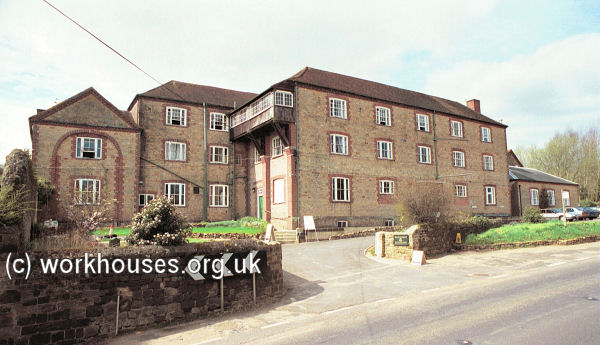
Midhurst main block from the south-east, 2001.
© Peter Higginbotham.
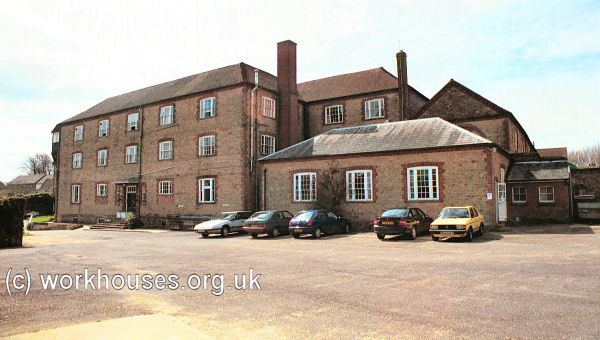
Midhurst main block from the north-east, 2001.
© Peter Higginbotham.
Two-storey ranges ran along the north and south sides of the courtyard. The north wing contained a shoemaker's shop, tailor's shop, weaver's shop, and a 'room for old people to pick wool in'. The western part of each of the two side wings was original a single storey in height but at some date was increased to two storeys.
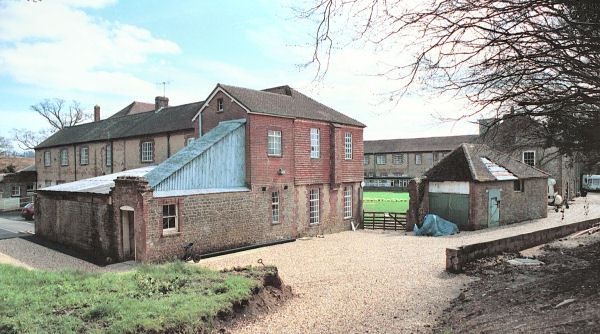
Midhurst workhouse from the north-west, 2001.
© Peter Higginbotham.
At the west of the courtyard were an ash-house, dead-house, bathing room and two 'prison' cells.
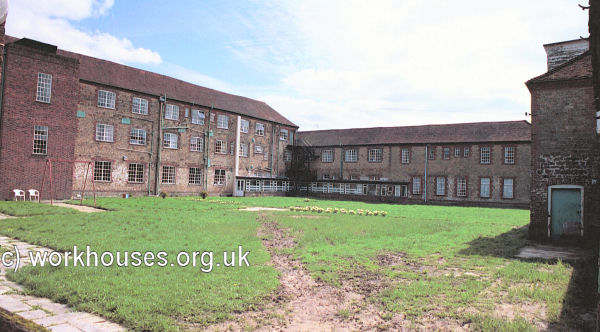
Midhurst courtyard from the north-west, 2001.
© Peter Higginbotham.
In 1930, the site became Budgenor Public Assistance Institution under the control of West Sussex County Council. In the mid-1970s, the council used the premises to provide temporary accommodation for homeless families. The buildings were later leased by the Christ For The Nations organization. In 2006, the property was converted into 42 apartments, prserving the bulk of the original workhouse buildings.
Staff
Inmates
Records
Note: many repositories impose a closure period of up to 100 years for records identifying individuals. Before travelling a long distance, always check that the records you want to consult will be available.
- West Sussex Record Office, County Hall, Chichester, West Sussex PO19 1RN. Holdings include Guardians' minutes (1835-1890); Births (1847-1933); Deaths (1835-1930); Creed registers (1894-1910); etc.
Bibliography
- Higginbotham, Peter Workhouses of London and the South East (2019)
Links
- None.
Unless otherwise indicated, this page () is copyright Peter Higginbotham. Contents may not be reproduced without permission.


